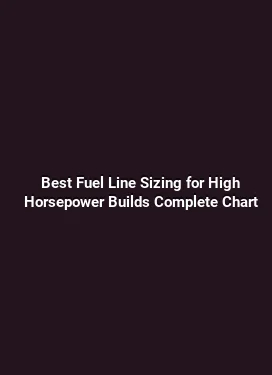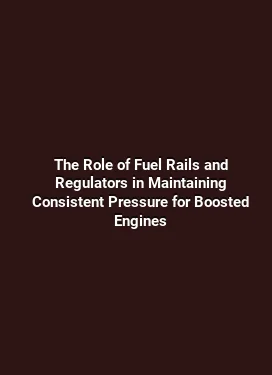Carbon Fiber Intake Manifold Benefits: Weight vs Performance Analysis
In the realm of high-performance engines, the intake manifold plays a pivotal role in delivering air to the combustion chambers with the right balance of velocity, pressure, and temperature. Carbon fiber intake manifolds have emerged as a compelling alternative to traditional aluminum or plastic designs, offering a unique blend of weight reduction, thermal management, and aesthetic appeal. This article delves into the practical implications of adopting carbon fiber for intake manifolds, examining how weight savings translate into real-world performance and what trade-offs are involved for different engine applications.
Weight Reduction and its Direct Impact on Powertrain Dynamics

Car enthusiasts and professionals often emphasize weight reduction as a catalyst for improved acceleration, handling, and fuel efficiency. The intake manifold, though not a primary mass contributor like the engine block or drivetrain components, still adds to the overall rotating and sprung weight footprint of the powertrain. Carbon fiber offers a significant advantage here due to its high strength-to-weight ratio. When compared to cast aluminum manifolds, a carbon fiber design can be lighter by a meaningful margin, sometimes on the order of several kilograms depending on the bore size and thickness of the plenum. In practical terms, this weight savings reduces the inertia of the intake system, enabling crisper throttle response and a slight, yet measurable, improvement in rotational energy during engine ramp-up and gear changes.
Beyond the raw numbers, the reduction in mass affects how quickly the intake system settles after a throttle input. A lighter manifold tends to have less momentum, which means the throttle plate or electronic throttle control can achieve more immediate air delivery, especially at high RPM ranges where the manifold’s volume acts as a transient reservoir. For turbocharged and supercharged setups, this can contribute to more predictable boost behavior and reduced turbo lag, particularly when paired with matched fuel and timing strategies that respond to manifold volume changes.
Thermal Management: Keeping Air Charge Cool and Consistent
One of the key arguments in favor of carbon fiber is its low thermal conductivity relative to metals. In an intake manifold, keeping the incoming air as cool as possible is beneficial because cooler air is denser, delivering more oxygen per intake stroke. A carbon fiber construct can act as a partial barrier against heat soak from the cylinder head and surrounding engine components, helping to maintain a more stable air charge temperature under dynamic driving conditions. This thermal behavior is particularly valuable in high-heat environments or under sustained high-load operation, where metal manifolds may transfer heat more readily into the air stream, subtly diminishing oxygen density and potentially altering volumetric efficiency during a run.
However, the thermal performance of carbon fiber is not purely passive. The matrix resin and the internal laminate structure must be engineered to minimize heat buildup within the plenum itself, which can occur if insulation is inadequate or if the manifold design traps heat from adjacent components. Manufacturers often incorporate strategic insulation layers or reflective coatings and select resin systems that balance stiffness, heat resistance, and structural integrity. For engines with aggressive intake temperatures and sophisticated management systems, the combination of material properties and design details can yield a net advantage in maintaining a more uniform air temperature across a wide range of operating conditions.
Material science considerations for temperature management

Multiple fiber orientations and ply schedules influence how heat propagates through a carbon fiber conduit. A balanced layup that avoids excessive anisotropy helps ensure consistent mechanical performance while providing adequate resistance to heat and mechanical vibrations. For competitive applications, some builders employ intermediate barrier layers or air gaps to further decouple heat transfer from the intake air path. The end result is a manifold that not only reduces mass but also contributes to a more stable charge temperature profile, which can support a smoother power curve and more repeatable performance on track days.
Airflow Path and Velocity Profiles Through Carbon Fiber Design
The geometry of the intake runner and plenum is a decisive factor in how effectively air is distributed to each cylinder. Carbon fiber enables complex, one-piece, highly optimized shapes that might be more challenging or expensive to reproduce with traditional metals. The ability to craft thin-walled runners with careful cross-sectional shaping can reduce internal friction and boundary layer effects, enabling higher air velocity at the valve throat without sacrificing plenum volume where it matters most. In practical terms, this translates to improved short-term torque and a more favorable air-fuel mixture response during rapid throttle transitions.
Additionally, the digital simulation and rapid prototyping capabilities associated with carbon fiber manufacturing permit iterative testing of runner lengths, plenum volumes, and merging branches. As a result, engineers can fine-tune resonance characteristics, plenum tuning, and runner phasing to optimize power delivery across target RPM ranges. The net effect is a manifold that can support a broader usable torque band, with smoother weighting of the torque peak and more linear throttle response, especially when combined with matched intake tract components such as throttle bodies, intake valves, and injector timing strategies.
Resonance, plenum sizing, and practical gains
Resonance tuning is a nuanced aspect of intake design. Carbon fiber allows for precise control over wall stiffness and slow-vibration modes, enabling designs that mitigate unwanted pressure fluctuations at critical RPM zones. A well-tuned plenum can minimize pressure losses and maximize volumetric efficiency (VE) during the engine’s operating envelope. While formula-driven expectations are useful, the true gains often appear as better throttle response at mid-range RPMs and a more consistent power delivery when the engine operates near the torque peak.
Durability, Reliability, and Long-Term Performance
Durability concerns for carbon fiber intake manifolds typically center on impact resistance, chemical compatibility, and thermal cycling. In automotive environments, manifolds must withstand vibrations, intake manifold bolts subject to vibration, and potential exposure to fuel vapors or cleaning agents. Modern carbon fiber systems employ toughened resin matrices and protective coatings that resist chemical attack and moisture ingress. The laminate structure is engineered to maintain stiffness under repeated thermal cycles, reducing the risk of microcracking that could compromise air sealing or structural integrity.
From a reliability perspective, the absence of corrosion in carbon fiber offers a clear advantage over traditional aluminum, particularly in humid climates or salt-exposed environments. That said, proper assembly torque, gasket selection, and sealing techniques remain critical. Any design that avoids leak paths and maintains a consistent seal across heat cycles will sustain performance gains without compromising durability. Routine inspection of mounting hardware and seals is advised for track-day enthusiasts and road-going builds alike.
Installation Considerations and Compatibility
Implementing a carbon fiber intake manifold requires careful attention to compatibility with the rest of the fuel and air system. The manifold must align with the throttle body or drive-by-wire unit, fuel rail positions, injector spacings, and sensor interfaces. Some manufacturers design carbon fiber manifolds as direct replacements for the stock unit, simplifying installation, while others offer modular components that require adapter plates or retuning the intake tract. In any case, ensuring a proper seal with high-quality gaskets and compatible O-ring materials is essential to prevent vacuum leaks, which can negate the expected performance benefits.
Another practical consideration is engine management. The ECU or aftermarket engine control unit needs to accommodate potential changes in air density, volume, and velocity profiles that come with a new manifold. While a carbon fiber design can enhance performance, it may also necessitate recalibration of fuel maps, ignition timing, and transient fuel delivery to maintain optimal air-fuel ratios across the RPM spectrum. In many cases, the broader system gains are most pronounced when the manifold upgrade is paired with complementary enhancements such as a high-flow intake, optimized fuel injectors, and appropriate intake camshaft timing adjustments.
Cost versus Benefit: Making a Prudent Choice
Cost considerations play a decisive role in the adoption of carbon fiber intake manifolds. Material and manufacturing processes for carbon fiber are more resource-intensive than those for sheet aluminum or plastic equivalents, which can translate into higher upfront costs. However, the weight reduction, thermal advantages, and potential improvements in throttle response and VE can justify the investment for enthusiasts who engage in competitive events, track days, or applications where every incremental performance gain matters. A pragmatic approach involves evaluating the total package: power gains, handling improvements from reduced mass, and the reliability and serviceability of the manifold under real-world operating conditions.
For street cars, the perceived benefits may be more subtle but still valuable. A lighter intake system can contribute to improved acceleration feel and better fuel economy under mixed driving, especially in configurations that prioritize high-efficiency components elsewhere in the intake tract. For race-oriented builds, the gains are often more pronounced, with a clearer signal in torque delivery and a more predictable power curve across the rev range. When evaluating options, it is prudent to review independent data from drive tests or dyno comparisons that reflect the specific engine configuration and supporting modifications.
Real-World Scenarios: Case Studies and Practical Examples
Consider a naturally aspirated V8 engine in a performance sedan seeking incremental improvements in mid-range torque. A carbon fiber intake manifold with optimized runner lengths could reduce air charge temperature and lower intake plenum inertia, resulting in a more linear torque curve. The ownership experience might include quicker throttle response and a slightly more aggressive pull as the engine approaches the mid-range power band. In a turbocharged prototype, the combination of lower mass and better thermal characteristics can complement the turbocharger’s response, delivering faster boost development and improved throttle consistency during high-load bursts.
In another scenario, a lightweight track-focused engine build may benefit from the reduced mass of the manifold, contributing to reduced rotational energy transfer during rectilinear transitions and corner exits. The maintenance routine would prioritize inspecting the mounting hardware, seals, and any heat shield or insulation layers that contribute to thermal management. The overall objective is to maintain consistency across sessions and ensure that the manifold continues to deliver the intended air-charge characteristics without inducing leaks or timing anomalies.
Maintenance, Inspection, and Longevity
Maintenance practices for carbon fiber intake manifolds center on preserving seal integrity, ensuring the absence of fuel or oil contamination, and verifying that all fasteners remain torqued to specification. Regular inspections for signs of resin micro-cracking, delamination, or surface damage are prudent, especially after track sessions or in high-heat environments. Cleaning should be performed with non-abrasive methods that do not degrade protective coatings or resin surfaces. Avoid aggressive chemical cleaners that could compromise the laminate or edge seals.
Longevity is influenced by how well the manifold is integrated into the broader intake system. A robust installation, compatible seals, and careful thermal management strategies contribute to a longer service life. Many owners find that the performance benefits persist across multiple seasons when the manifold is operated within its design envelope and not pushed beyond its rated operating limits by extreme duty cycles or improper tuning.
Summary of Practical Takeaways
Carbon fiber intake manifolds offer a compelling blend of reduced weight, enhanced thermal behavior, and potential improvements in air charge delivery. The technology enables advanced geometric designs that optimize airflow and resonance characteristics, supporting a more responsive throttle and improved torque delivery. Upgrading the manifold should be considered as part of a holistic performance plan that includes intake tuning, fuel delivery, and engine management to realize the full spectrum of benefits while maintaining reliability and drivability. Real-world results depend on a careful balance of material choices, wall thickness, layup orientation, and compatibility with the engine’s air, fuel, and control systems. When executed with attention to detail, carbon fiber manifolds can provide tangible, repeatable advantages for both enthusiasts and professional racers alike.






